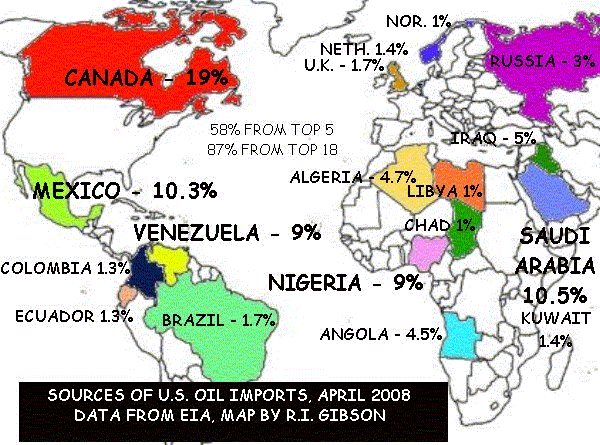
Some interesting oil industry statistics - imports/exports
©1997-2009 Gibson Consulting

 | By Richard Gibson:
What Things Are Made Of
The story of America's dependency
on mineral commodities (including oil) in everyday life.
Buy the book. Print (312 pages): $17.95; electronic (PDF) $9.99. Additional e-versions details to come.
visit the blog | Share this article
|
Support this page! |
US Oil Exports
Today, the US does exports crude oil - about 20,000 barrels per day, all of it to Canada. We could keep it in the US, but it would cost more to ship it to a US refinery (that might already be oversupplied) 1500 miles away than to a Canadian refinery 200 miles away. It all comes back to us as refined product, anyway -- mostly gasoline, because even with all our refineries going flat out, we cannot process enough crude oil (including the 4 million barrels per day that we produce, and the 9 million barrels per day we import) to meet our needs. So we also import about 3 million barrels of refined product (mostly gasoline) every day, most if it from Canada.
Q: How much oil do we export? Is it true that Oil is traded just as a commodity and resold it various markets? We don't actually put oil on a ship and send it around the world? I had a argument with someone who claimed we export just as much oil as we import. Is this true..?
A (Sept. 2008): Of course oil is put on ships and sent around the world. 10,000,000 barrels of crude oil per day comes into the US on tankers or by pipeline. "We" (as in US) don't put much crude oil at all into the export stream. The rest of the world does, because we are the main consumer - the US consumes as much petroleum as China, India, Russia, Germany, and Japan, combined.
The US only exports about 19,000 barrels of crude oil per day, every drop of it to Canada, as exports of convenience - from a US oil field to a nearby Canadian refinery rather than a distant - or fully utilized - US one.
We also export over 1 million barrels per day of refined products. You can see the total distribution here. Change the drop-down menu for 'product' to see the distribution of each product.
Large portions of this exported material include things like petroleum coke, a residual refinery product for which there is little market in the US so it is sold to Mexico and elsewhere as industrial fuel. All of the things that we export have little market in the US, or they would be sold here. Even gasoline - Mexico cannot refine enough gasoline for its own use, so it must import gasoline just as the US does. If there were shortages of gasoline in the US, it might be meaningful to talk about selling every drop here, but that is not the case. The fact that we export 183,000 barrels of gasoline per day has no impact on the price, given that we consume 9,200,000 barrels of gasoline per day.
So, even if you count all the petroleum products - of which we also import about 3,100,000 barrels per day as of the first of August, plus 10.2 million barrels per day of crude oil - total exports is about 1.3 million barrels per day, or about 10% of the total 13.3 million we import, and about 6% of total consumption of 20,000,000 barrels per day. Before you say "Why do we export any at all" - it is as I said above - either convenience (to SAVE money) or it is materials for which there is no significant market in the US. The exports do not create shortages, nor do they impact the price, within the US.
| OIL IMPORT QUIZ |
|
What country provides the single largest volume of the US's oil imports (2001-2007)?
| |
| |
|
SOURCES OF US OIL IMPORTS
The Map below is based on data from Energy Information Administration for 2003,
and includes both imported crude and petroleum products (see note and table below
the map for 2001-2002). Canada, Saudi Arabia, Mexico, and Venezuela are the leading
suppliers. The map shows all countries that supply 1% or more of our imports,
and the countries shown total about 85% of all imports.
2004
UPDATE: US Imports total about 61% of consumption: 13.12 million barrels per day
in July 2004, out of total consumption of 21.4 million barrels per day. At the end of 2005, US production was at the lowest point since the late 1940s (4.86 million b/d) and imports accounted for 67% of total consumption.
| NOTE ON IMPORTS FROM IRAQ: US oil imports from Iraq have fluctuated greatly over the past 15 years. In 1990, imports from Iraq accounted for about 6.4% of our imports. From 1991 to 1996, due to sanctions, Iraq provided NO exports to the US. In 1999 (average 6.7%), 2000 (5.4%), 2001 (6.7%), and 2002 (3.9% - yes, less than four percent), amounts varied a lot from month to month. More data at Energy Info. Administration |

|
In 2002, Canada led the world in our sources of imports, at 17%, with Saudi
Arabia (13.7%), Mexico (13.5%), and Venezuela (12%) in a virtual three-way tie
for second. The year before the percentages were Canada - 15.4%, Saudi Arabia
- 14%, Venezuela - 13%, and Mexico - 12.1%. Canada has been the leader since at least 2001. In 2002,
US imports from the Persian Gulf region amounted to 19.8 percent of our total
imports. The same year, a total of 40% came from OPEC member nations -- which
include countries such as Venezuela and Indonesia that are outside the Persian
Gulf. More Information
While the countries on the map above supply the greatest proportion of US crude and products imports, in January to March 2006, the US also imported crude oil and/or refined products from Argentina, Australia, Azerbaijan, Bahrain, Belarus, Belgium, Bolivia, Brazil, Brunei, Cameroon, Chad, Chile, China (both mainland and Taiwan), Congo (Brazzaville), Costa Rica, Denmark, Egypt, El Salvador, Estonia, Finland, France, Gabon, Germany, Guatemala, Hungary, India, Indonesia, Italy, Ivory Coast, Jamaica, Japan, Kazakhstan, Latvia, Libya, Lithuania, Malaysia, Midway Islands, Netherlands, Netherlands Antilles, Oman, Peru, Poland, Portugal, Qatar, Romania, Russia, Senegal, Singapore, South Africa, Spain, Sweden, Syria, Thailand, Tonga, Trinidad and Tobago, Turkey, Turkmenistan, Ukraine, United Arab Emirates, Uruguay, Viet Nam, and Yemen. Source
World Consumers and Importers 2003: see EIA here
for more info.
Leading Oil Consumers | Leading Oil Importers | Leading sources of US imports |
USA (20 million barrels per day)
China (5.6)
Japan (5.5)
Germany | USA (11.1 million b/d)
Japan (5.3)
Germany (2.5)
South Korea (2.2) | Canada (17%)
Saudi Arabia (14.5%)
Mexico (13%)
Venezuela (11%) |
World oil export leaders and their reliance on the U.S. consumer market
(numbers are in million barrels per day, 2004 data from EIA)
chart ©2006 Gibson Consulting |
| Country | Net Oil Exports | U.S. Imports | Reliance on U.S. Market |
| Saudi Arabia | 8.7 | 1.27 | 15% |
| Russia | 6.6 | 0.047 | <1% |
| Norway | 2.9 | 0.1 | 3% |
| Iran | 2.5 | 0 | 0% |
| Venezuela | 2.3 | 1.01 | 44% |
| UAE | 2.3 | 0.021 | <1% |
| Kuwait | 2.2 | 0.27 | 12% |
| Nigeria | 2.1 | 1.16 | 55% |
| Mexico | 1.8 | 1.66 | 92% |
| Canada | 1.8 | 1.8 | 99+% |
| Algeria | 1.6 | 0.26 | 16% |
| Iraq | 1.4 | 0.57 | 41% |
| Libya | 1.3 | 0.051 | 4% |
| Kazakhstan | 1.0 | 0 | 0% |
| Qatar | 1.0 | 0 | 0% |
Compiled by Dick Gibson, Gibson Consulting, 301 N. Crystal St., Butte, MT 59701
Want to know more?
Gibson Consulting recommends: Read The Prize, by Daniel Yergin. |


©1997-2009 Gibson Consulting
Background image of drilling well in Utah in 1981 © 2000 by Dick Gibson




